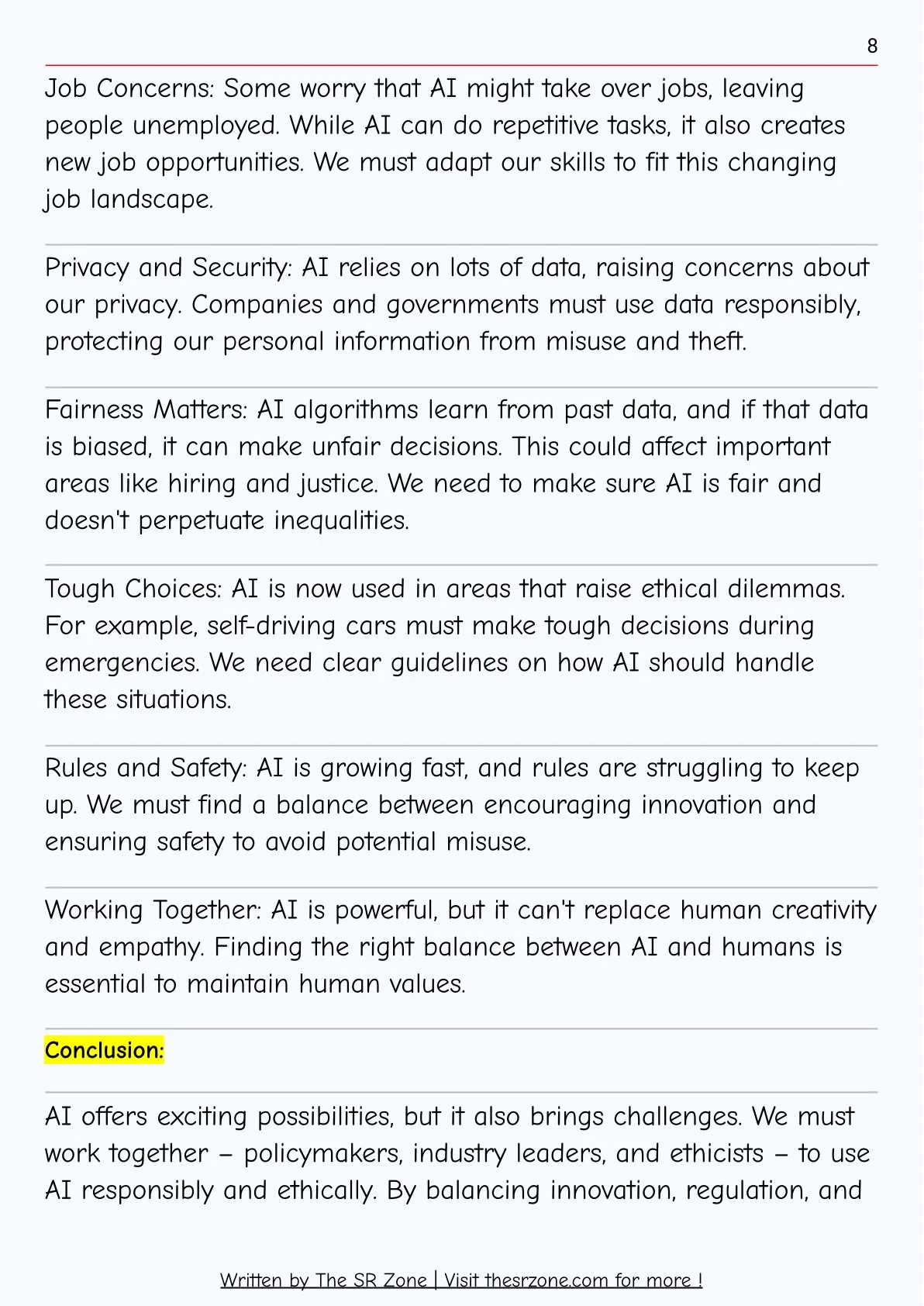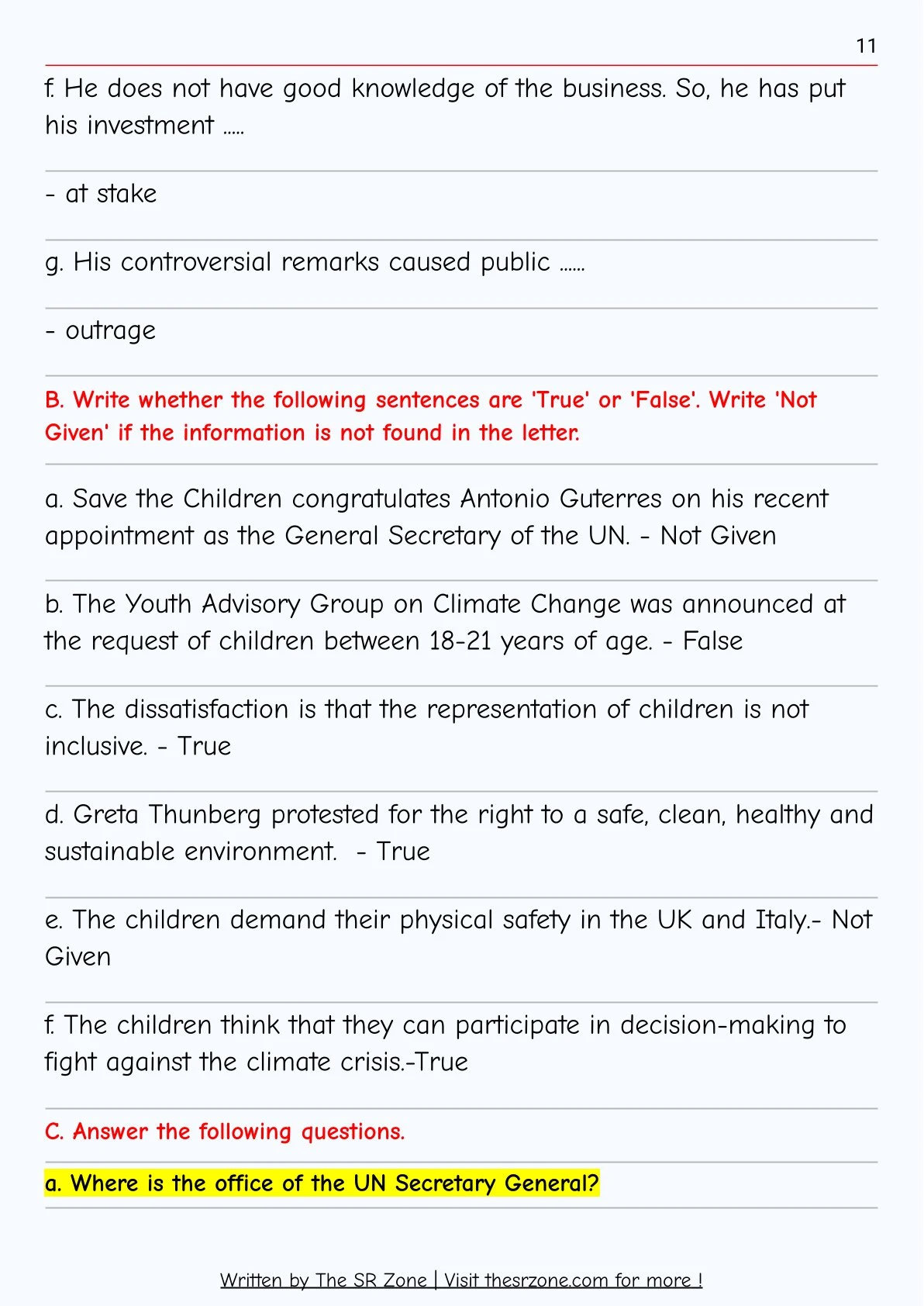Class 10 English Unit 1 Reading I & Reading II Exercise - Current Affairs And Issues
For complete notes of Class 10 English Book, go to this link - Class 10 English Guide & Notes.
Class 10 English Unit 1 Current Affairs And Issues Exercise
Class 10 English Book Unit 1 explores about how emerging technologies and global issues shape our world. Let's examine the summary, question answer, exercise solution, grammar and reading I and II of this unit.
Reading I: How Driverless Cars Will Change Our World
This passage discusses the rise of autonomous vehicles and their potential impacts. Driverless cars, also known as self-driving cars, use sensors and software to drive themselves without human input. The article outlines several ways these innovations could transform transportation systems. For example, road accidents may decrease as computers don't become distracted, drunk or tired like people. Traffic jams could ease if vehicles communicate electronically to coordinate traffic flow. Elderly and disabled individuals may gain new mobility if cars drive themselves. It's fascinating how the author conveys both the possibilities and uncertainties of this developing technology.
Reading II: Open Letter to UN Secretary-General Antonio Guterres
This letter addresses the global issue of climate change and calls on the UN to take urgent action. It lays out the science clearly and persuasively argues that more ambitious targets and policies are needed to meet climate goals.
Grammar and Writing Exercises
Grammar I: Focus on sentence structure and the use of present perfect tense.
Writing I: Crafting persuasive essays related to technological advancements.
Grammar II: Emphasis on modal verbs and their usage in expressing possibilities and obligations.
Writing II: Writing formal letters and open letters addressing global leaders on critical issues.
Unit 1 Current Affairs and Issues
Reading - I
How Driverless Cars Will Change Our World
C. Answer the following questions.
a. Mention any three features of the driverless car.
Answer : Three features of driverless cars are:
They can operate without a human driver and navigate on their own.
They use active sensors to detect and respond to the environment around them.
They can be controlled through apps, allowing people to request rides easily.
b. Describe the benefits of driverless technology.
Answer: There are many benefits of driverless technology. First is Improved safety. Autonomous vehicles can reduce accidents caused by human error. Second, Sustainability, They can lower carbon emissions and promote eco-friendly transportation. Driverless cars can make long journeys more convenient. Autonomous technology can take people out of dangerous working environments.
c. What, according to Camilla Fowler, is the special advantage of automated vehicles?
Answer: According to Camilla Fowler, the special advantage of automated vehicles is their potential to provide safer roads and reduce fatalities. They have the capability to improve road safety and lower the number of accidents that occur annually.
d. What are the problems with driverless vehicles in David Hynd's view?
Answer: In David Hynd's views, the problems with driverless vehicles include their ability to cope with human drivers who may not always follow traffic rules or drive calmly. Ensuring that driverless cars can handle unpredictable human behaviour is a significant challenge.
e. What are scientists doing to make driverless technology safer?
Answer: Scientists are making driverless technology safer by testing and addressing its performance in complex and unpredictable human environments. At places like the Mcity Test Facility at the University of Michigan, experts test various scenarios that autonomous vehicles may encounter on real roads to improve their safety and effectiveness.
f. Do you think driverless technology is safer than human-controlled driving? Why?
Answer: Driverless technology removes the most significant cause of car accidents - human error. Computers can sense the road better, react faster and follow rules more perfectly. So though not completely foolproof yet, driverless technology undoubtedly has the potential to significantly reduce accidents and save many lives compared to human-controlled driving.
D. Think of any three other areas where artificial intelligence (Al) has been used. What are the benefits of using Al in these areas? Share your ideas with the class.
Artificial intelligence (AI) is being used in many more areas. Three further areas where AI has significantly improved things are:
Healthcare: AI is utilised for disease diagnosis, medical image analysis, drug discovery, and personalised treatment plans.
Environment : AI is being utilised to solve environmental issues including climate change, deforestation, and the preservation of biodiversity. AI algorithms can detect and forecast environmental changes via data analysis, allowing more efficient strategies for environmental protection and sustainable practices.
Business : Customer service has undergone a radical change thanks to AI-powered chatbots and virtual assistants. Customers will be more satisfied and companies will run more smoothly as a result of this intelligent system's ability to manage consumer concerns, provide immediate assistance, and even handle complicated interactions.
Writing I
The use of Al in the technology is not only making people's liveseasier but bringing new challenges. Write a newspaper article about the challenges brought by the advancement of AI in technology.
Title: The Rise of AI in Technology: Facing Challenges Together
July 22nd, Kathmandu Post
In recent years, Artificial Intelligence (AI) has taken the world by storm, changing how we live, work, and interact. From helpful virtual assistants on our phones to decision-making algorithms, AI has made life easier in many ways. But with these advancements come important challenges that we need to understand and address.
Job Concerns: Some worry that AI might take over jobs, leaving people unemployed. While AI can do repetitive tasks, it also creates new job opportunities. We must adapt our skills to fit this changing job landscape.
Privacy and Security: AI relies on lots of data, raising concerns about our privacy. Companies and governments must use data responsibly, protecting our personal information from misuse and theft.
Fairness Matters: AI algorithms learn from past data, and if that data is biased, it can make unfair decisions. This could affect important areas like hiring and justice. We need to make sure AI is fair and doesn't perpetuate inequalities.
Tough Choices: AI is now used in areas that raise ethical dilemmas. For example, self-driving cars must make tough decisions during emergencies. We need clear guidelines on how AI should handle these situations.
Rules and Safety: AI is growing fast, and rules are struggling to keep up. We must find a balance between encouraging innovation and ensuring safety to avoid potential misuse.
Working Together: AI is powerful, but it can't replace human creativity and empathy. Finding the right balance between AI and humans is essential to maintain human values.
Conclusion:
AI offers exciting possibilities, but it also brings challenges. We must work together - policymakers, industry leaders, and ethicists - to use AI responsibly and ethically. By balancing innovation, regulation, and ethics, we can create a better world where AI serves us while preserving what makes us human.
Unit 1 - Reading II
Open Letter to UN Secretary-General Antonio Guterres
C. Answer the following questions.
a. Where is the office of the UN Secretary General?
Answer: The office of the UN Secretary-General is in New York, United States.
b. What is the purpose of writing this letter to Antonio Guterres?
Answer: The letter asks him to include children in the Youth Advisory Group on Climate Change, so they can have a say in climate action decisions.
c. Why was the Youth Advisory Group announced?
Answer: The group was announced to get advice from young leaders (18-28 years old) on how to tackle climate change.
d. What roles have children played in the time of climate crisis?
Answer: Children have joined school strikes, used social media, and talked to leaders to ask for action on climate change.
e. Describe Greta Thunberg and Fabrizio's contributions.
Answer: Greta inspired a global movement for climate action with her solo protest. Fabrizio speaks out for a green recovery and urges urgent action.
f. What is the final demand of the children?
Answer: The children want to be included in the Youth Advisory Group and have a safe space to influence important climate events like COP26.
D. As a student, what roles can you play to control climate change and its effects?
As a student, here are some actions I can take to control climate change and its effects:
Conserving Energy: I will turn off lights and electronics when not in use, and encourage my family and friends to do the same.
Reducing Waste: I will recycle paper, plastic, and other materials, and avoid using single-use plastics like straws and bags.
Using Eco-friendly Transportation: I will walk, bike, or carpool to school to reduce emissions from vehicles.
Saving Water: I will turn off the tap while brushing my teeth and take shorter showers to save water.
Planting Trees: I will participate in tree-planting activities in my community to help absorb carbon dioxide.
Spreading Awareness: I will talk to my classmates and teachers about climate change and its impacts to raise awareness.
Supporting Renewable Energy: I will learn about renewable energy sources and encourage my family to use them when possible.
Advocating for Change: I will write letters to local leaders and participate in climate action events to demand action on climate change.
Being a Role Model: I will lead by example and show others how to make small changes in their daily lives to protect the environment.
Learning and Educating Others: I will continue to educate myself about climate change and share what I learn with my friends and family to inspire them to take action too.
Writing II
Write a letter to the Mayor of your municipality or the Chairperson of your rural municipality requesting him/her to involve the representatives of children in the decision-making process related to children's issues in your municipality/rural municipality.
LalitpurJuly 3, 2023,
The Mayor
Kathmandu Metropolitan City
Kathmandu, Nepal
Dear Sir,
I am Shriram, a 18-year-old resident of Kathmandu, concerned about the well-being of children in our municipality/rural municipality. I urge you to involve representatives of children in decision-making regarding issues that directly impact us.
Children have valuable insights and ideas about education, safety, the environment, and more. By creating a platform like a Children's Advisory Council, we can actively contribute to our community's development and advocate for child-friendly policies.
Including children in decision-making will lead to more inclusive and effective solutions. We care deeply about the future of our community and seek your support to make a positive difference.
Thank you for considering our request. Your action will empower us to create a brighter future for all.
Sincerely,
Shriram Lamichhane
















